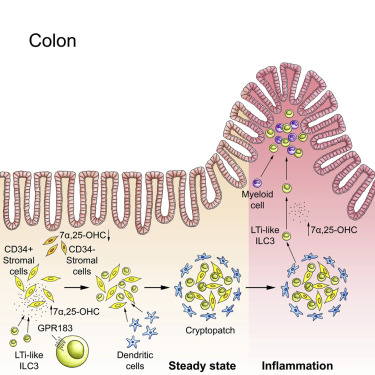Immunity ( IF 32.4 ) Pub Date : 2018-01-16 , DOI: 10.1016/j.immuni.2017.11.020 Johanna Emgård 1 , Hana Kammoun 1 , Bethania García-Cassani 2 , Julie Chesné 2 , Sara M Parigi 3 , Jean-Marie Jacob 4 , Hung-Wei Cheng 5 , Elza Evren 1 , Srustidhar Das 3 , Paulo Czarnewski 3 , Natalie Sleiers 1 , Felipe Melo-Gonzalez 6 , Egle Kvedaraite 1 , Mattias Svensson 1 , Elke Scandella 5 , Matthew R Hepworth 6 , Samuel Huber 7 , Burkhard Ludewig 5 , Lucie Peduto 4 , Eduardo J Villablanca 3 , Henrique Veiga-Fernandes 2 , João P Pereira 8 , Richard A Flavell 9 , Tim Willinger 10

|
Group 3 innate lymphoid cells (ILC3s) sense environmental signals and are critical for tissue integrity in the intestine. Yet, which signals are sensed and what receptors control ILC3 function remain poorly understood. Here, we show that ILC3s with a lymphoid-tissue-inducer (LTi) phenotype expressed G-protein-coupled receptor 183 (GPR183) and migrated to its oxysterol ligand 7α,25-hydroxycholesterol (7α,25-OHC). In mice lacking Gpr183 or 7α,25-OHC, ILC3s failed to localize to cryptopatches (CPs) and isolated lymphoid follicles (ILFs). Gpr183 deficiency in ILC3s caused a defect in CP and ILF formation in the colon, but not in the small intestine. Localized oxysterol production by fibroblastic stromal cells provided an essential signal for colonic lymphoid tissue development, and inflammation-induced increased oxysterol production caused colitis through GPR183-mediated cell recruitment. Our findings show that GPR183 promotes lymphoid organ development and indicate that oxysterol-GPR183-dependent positioning within tissues controls ILC3 activity and intestinal homeostasis.
中文翻译:

通过受体 GPR183 感知氧固醇促进先天淋巴细胞的淋巴组织诱导功能和结肠炎症
第 3 组先天淋巴细胞 (ILC3) 感知环境信号,对肠道组织的完整性至关重要。然而,哪些信号被感知以及哪些受体控制 ILC3 功能仍然知之甚少。在这里,我们显示具有淋巴组织诱导物 (LTi) 表型的 ILC3 表达 G 蛋白偶联受体 183 (GPR183) 并迁移至其氧甾醇配体 7α,25-羟基胆固醇 (7α,25-OHC)。在缺乏Gpr183或 7α,25-OHC 的小鼠中,ILC3 未能定位到隐斑(CPs)和分离的淋巴滤泡(ILFs)。Gpr183ILC3s 的缺乏导致结肠中 CP 和 ILF 形成的缺陷,但在小肠中没有。成纤维细胞基质细胞的局部氧甾醇产生为结肠淋巴组织发育提供了重要信号,炎症诱导的氧甾醇产生增加通过 GPR183 介导的细胞募集引起结肠炎。我们的研究结果表明,GPR183 促进淋巴器官发育,并表明组织内氧甾醇-GPR183 依赖性定位控制 ILC3 活性和肠道稳态。



























 京公网安备 11010802027423号
京公网安备 11010802027423号